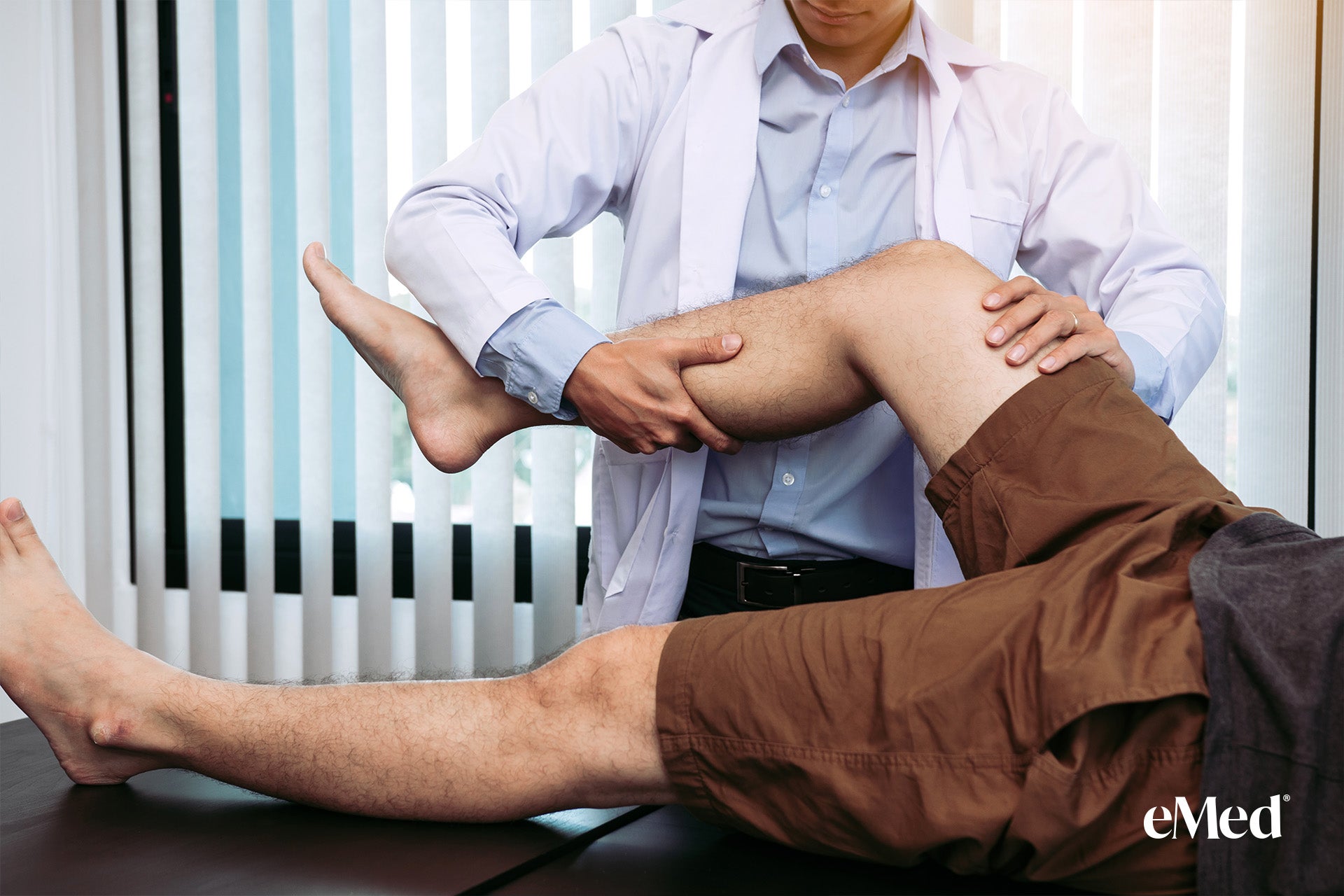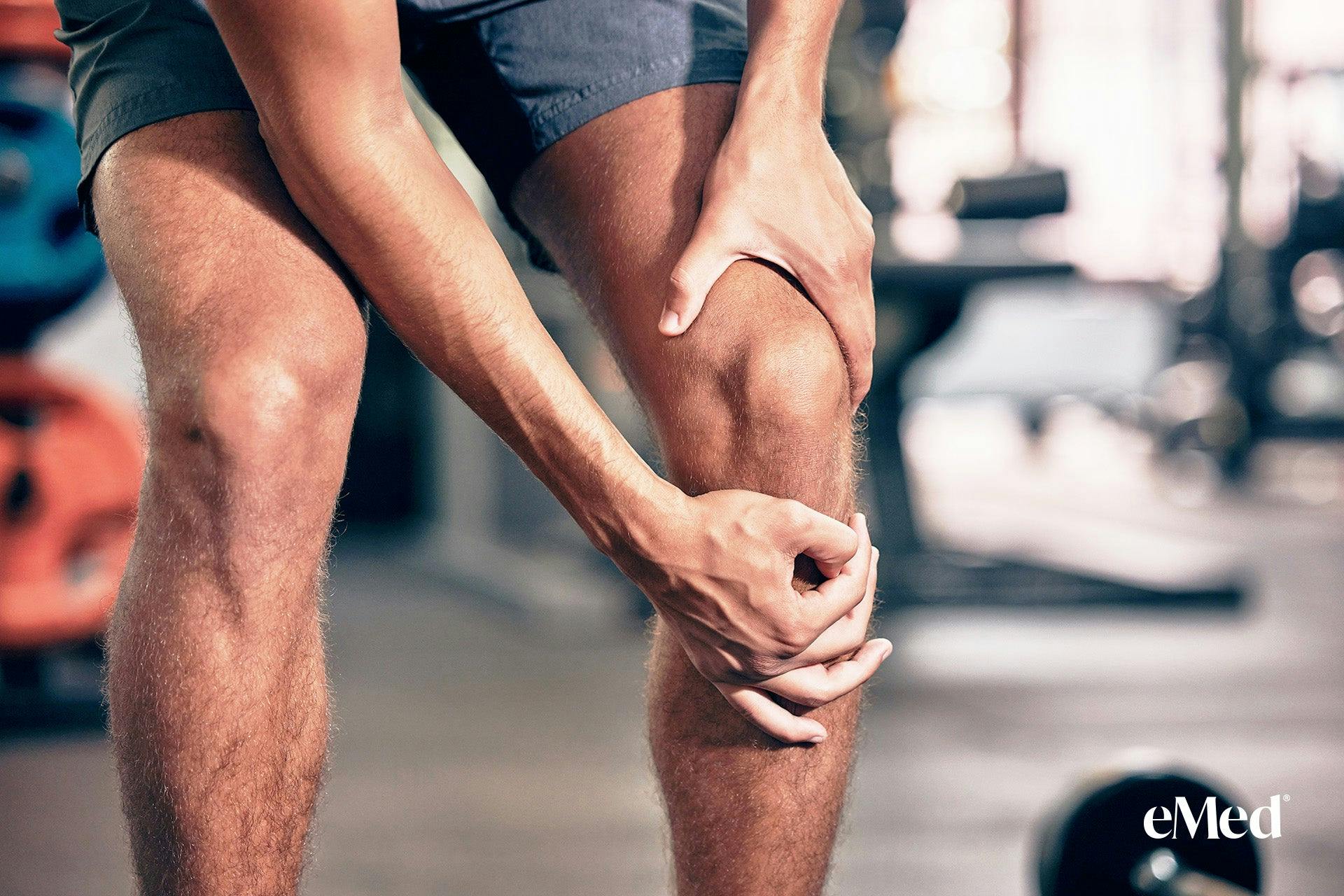The cause of knee pain is dependent on many things, including the type of injury and knee structure involved. For the purpose of this blog, we will focus on osteoarthritis (OA), ligament, tendon and meniscus injuries.
Whether it stems from osteoarthritis (OA), meniscal injuries, ligament injuries, or tendinopathy, the impact on daily life can be significant. Fortunately, physiotherapy offers a holistic approach to manage knee pain, addressing both the symptoms and underlying causes. In this blog, we will delve into the benefits of physiotherapy for knee pain, explore common types of knee issues, debunk myths surrounding knee pain, and introduce the innovative eMed MSK physiotherapy service.
Benefits of Physiotherapy for Knee Pain:
Physiotherapy plays a crucial role in the management of knee pain by improving mobility, strength, and function while reducing pain and inflammation. Through a combination of exercise, education and activity modifications, physiotherapists tailor treatment plans to each individual's specific needs, promoting long-term recovery and preventing future injuries.
Types of Knee Pain:
- Osteoarthritis (OA): OA, the most common form of arthritis, occurs when the articular cartilage in the joint becomes inflamed, painful, stiff and swollen over time. Physiotherapy interventions focus on education of the diagnosis, strengthening exercises for the muscles surrounding the knee joint, improving joint mobility, and providing pain relief through activity modifications, and over the counter medications via a community pharmacist. Read more on Physiotherapy for Osteoarthritis: Improve Mobility & Reduce Pain here.
- Meniscal injuries: The menisci are two crescent shaped cartilage structures that sit within the knee joint, between the articular joint cartilage. A good way to visualize the meniscus is as if it were a sandwich. The bread of the sandwich is the articular joints at the top and bottom of the knee joint, and the meniscus is the sandwich filling e.g. the ham or cheese.
Meniscal associated pain, often due to a tear in the meniscus (but not always) can result from a twisting mechanism in the knee joint. Meniscal associated pain can also present as a degenerative meniscal tear over a longer period of time, seemingly absent of any mechanism of injury.
Physiotherapy aims to restore normal movement patterns, strengthen muscles, and improve proprioception to support the healing process. - Ligament Injuries: The ligament is a structure responsible for connecting one bone to another bone, offering joint stabilization. Ligament injuries are often described as a sprain. When an Injury occurs to the knee joint ligaments, including the anterior cruciate ligament (ACL), posterior cruciate ligament (PCL), or collateral ligaments, this can increase knee instability, and pain presents. Physiotherapy focuses on restoring this stability through strengthening and proprioception or balance targeted rehabilitation.
- Tendinopathy: Tendon structures connect muscles to bones, and are effectively an extension of the muscular tissue. A tendon injury can be described as a strain.
Tendinopathy, also known as tendinitis or tendonitis, can present either in the acute phase as a reactive injury with swelling and pain. It can subsequently progress to a degenerative or disrepaired phase; if not appropriately managed in the acute phase.
Physiotherapy interventions include activity modification and a graded progressive exercise programme, with the aim to alleviate symptoms and promote tendon healing and return you to your sport or activity that has been impacted.

- Patellofemoral Pain (PFP): PFP is a common knee condition characterized by pain around the kneecap. It typically presents with pain associated with activities including climbing stairs, squatting and running. Identifying the main cause of PFP and treating it effectively can be challenging. Physiotherapy aims to offload the patellofemoral joint, whilst introducing specific exercises to strengthen the surrounding joint, and then gradually reloading the knee to activities such as running.
Best Physiotherapy Exercises for Knee Pain?
In short, there is no single best exercise for a specific diagnosis or injury classification, the best exercises provided will be tailored according to the presenting symptoms, and what can be performed without further exacerbation of symptoms.
There are some standard principles towards exercise prescription and rehabilitation, including strengthening, mobility, stretching and proprioception, however the choice of exercise variation will differ from person to person.
Read more: Physiotherapy vs. Chiropractic vs. Osteopathy
Jargon & myth Buster:
- Cartilage Damage: While cartilage damage can contribute to knee pain and stiffness, it doesn't necessarily mean surgery is the only option. Physiotherapy interventions can help optimize joint mechanics, reduce inflammation, and promote tissue healing.
- Sprain VS Strain: A strain is an injury to a tendon, which anchors a muscle to a bone, or to the muscle itself. Whereas a sprain is an injury to the ligament, which attaches to two bones.
- Rheumatoid Arthritis (RA) VS Osteoarthritis (OA): RA is an autoimmune disorder that can affect multiple joints, as well as other symptoms such as fatigue. OA is a symptomatic painful and stiff joint that can worsen over time.
- Is knee clicking damaging? While knee clicking can be concerning for the individual experiencing it, it is often harmless and doesn’t necessarily indicate a serious issue. Knee clicking can be due to a number of factors, and is mostly due to soft tissue interference around the tendons and patellofemoral joint of the knee.
eMed MSK Physiotherapy Service:
The eMed MSK physiotherapy service offers a comprehensive approach to managing knee pain, combining digital-first consultations with personalized exercise management programs. Through telehealth appointments and an intuitive exercise platform, patients can access expert guidance and support from the comfort of their homes, with the option for in-person sessions as needed.
- Crossley, K. M., Stefanik, J. J., Selfe, J., Collins, N. J., Davis, I. S., Powers, C. M., ... & Vicenzino, B. (2016). 2016 Patellofemoral pain consensus statement from the 4th International Patellofemoral Pain Research Retreat, Manchester. Part 1: terminology, definitions, clinical examination, natural history, patellofemoral osteoarthritis and patient-reported outcome measures. British Journal of Sports Medicine, 50(14), 839-843.
- McAlindon, T. E., Bannuru, R. R., Sullivan, M. C., Arden, N. K., Berenbaum, F., Bierma-Zeinstra, S. M., ... & Osani, M. (2014). OARSI guidelines for the non-surgical management of knee osteoarthritis. Osteoarthritis and Cartilage, 22(3), 363-388.
- Filbay, S. R., Culvenor, A. G., Ackerman, I. N., & Russell, T. G. (2017). Quality of physiotherapy management for patients with knee osteoarthritis: a multinational cross-sectional study. BMC Musculoskeletal Disorders, 18(1), 1-11.



